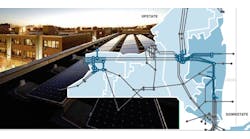A distributed energy storage network of 8,000 batteries located at 7,000 telecom facilities in France has reduced utility demand by 10 to 15 MW during two demand response events. And now the company that managed the program wants to bring it to the U.S.
Actility, which provides IoT-based grid balancing and demand response programs, wants to launch its program in the US by partnering with utilities and energy providers in the same way it does in Europe. In addition, it is seeking to work with companies, like France’s Orange Telecom, that have distributed battery networks, said Cedric De Jonghe, the energy business manager for Actility.
Orange Telecom has batteries in the 10- to 20-kW size range at 7,000 locations in France, and was one of Actility’s first partners, “lending” the batteries–and getting paid for it–during critical peak periods on the grid system. Actility aggregated the batteries to respond to the high peak periods.
“In 2017 we have experienced two activations thus far during moments when the electricity grid in France was facing a critical situation,” said De Jonghe.
Actility in 2010 began offering demand response services and started searching for ways to implement non-traditional demand response programs, De Jonghe said.
“We were looking for flexibility in highly distributed sources” in industries such as the telecom industry, he said. It launched its green demand response program in 2016.
In its first green demand-response project, Actility partnered with Orange, in addition to RTE, the largest Transmission System Operator (TSO) in Europe, and Enedis, the largest French Distribution System Operator, to create a “clean demand response” program that responds to spikes in energy demand.
The system has been called into action several times already, according to the company. In doing so, batteries reduced electric demand on the grid a temporary 10 MW initially, and more recently 15 MW.
Join Microgrid Knowledge at the Energy Storage Association’s Expo April 19 for a panel on “Resilient Design: Micro? Nano? How Integrated Systems Excel.”
Under the program, Actility defines the parameters of each project, specifying how much demand response it will deliver, how quickly it can respond to an event, and how much it will discharge the batteries it uses, De Jonghe said. This process is called certification.
“We certify a portfolio of batteries,” he explained. “Say we have a pool of 8,000 batteries, and the capability of delivering grid service.” Through this certification process, the company guarantees to the grid operator that if it experiences shortages, the company can deliver demand response services through the distributed battery systems.
France has needed the demand response services because of strikes that have closed large power units, he noted.
In the partnership with Orange Telecom, Actility promises to discharge the batteries by no more than 50 percent. “We define with the owner of the batteries up to which limit we can discharge batteries,” he said.
Distributed energy storage from other industries can also be used to create the demand response, he said. For example, when enough homeowners begin to use batteries, the company could aggregate them into a network of distributed batteries.
Distributed energy storage serves dual purpose
“One of the good things about this project is we use existing batteries, already connected to the grid, already providing backup power supply to telecom operators. They already have a certain purpose.” By operating them in an intelligent way, the company can deliver demand response and pay the battery owners, providing additional revenue streams to those companies.
Actility monitors a number of things, including the state of the electric grid and possible shortages. The company also monitors the flexibility of the pool of batteries and the impact of its program on the lifetime of the batteries, he said.
Because the company is dealing with thousands of sites, it can’t afford to make mistakes, De Jonghe said.
Another demand response application for the company is water pumping stations. In a water distribution and treatment station, up to 90 percent of the electricity is used to run pumps. But the pumping process is flexible, allowing utilities to shift pumping from peak periods to off-peak.
For utility companies, such demand response programs are less expensive than investing in power plants that are designed to meet peak demand, De Jonghe said.
“We are low in investment costs compared to a utility company that has to invest in power plants only used for peak power loads a few times a year. There’s a great business case for this.”
Actility provides demand response and grid balancing solutions, using ThingPark Energy, a platform for the IoT network that can monitor and remotely control many different types of processes to take advantage of their flexibility through demand response.
Track news about distributed energy storage by subscribing to the free Microgrid Knowledge newsletter.







